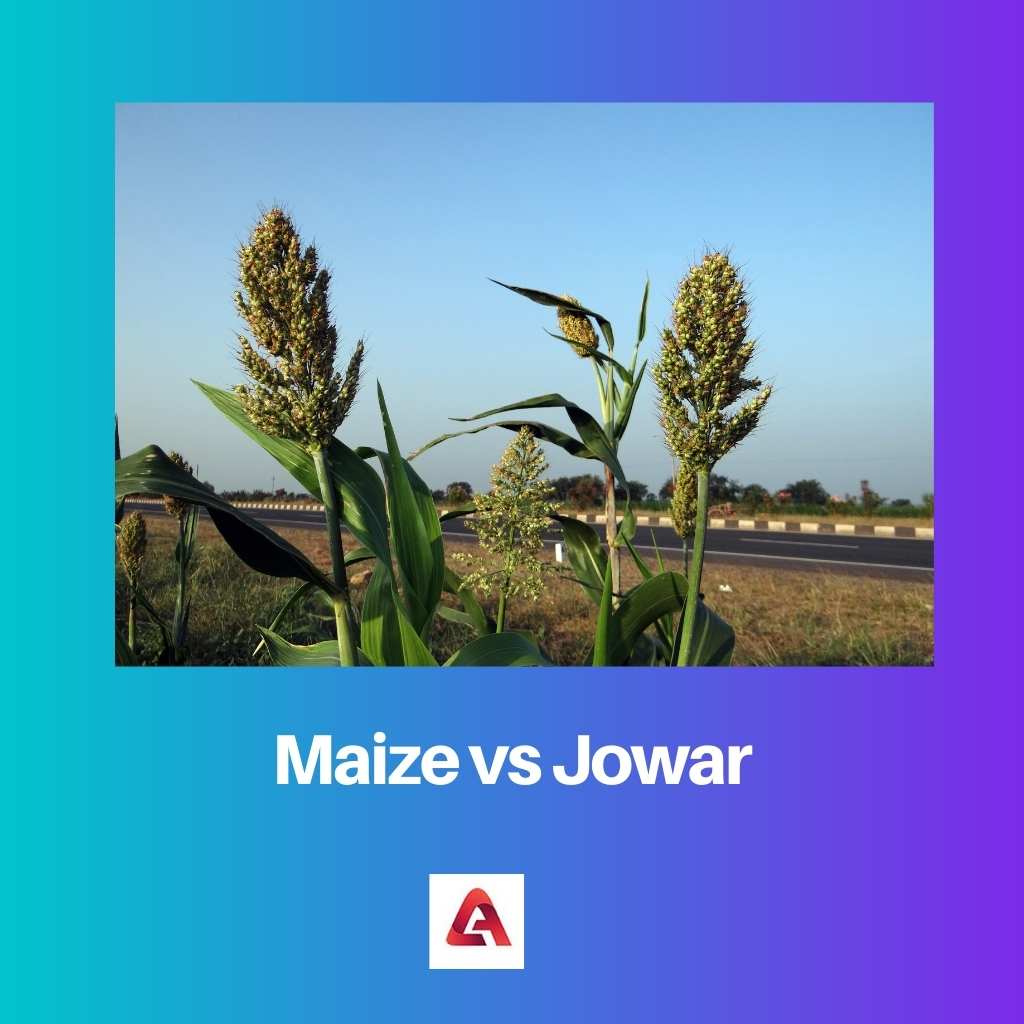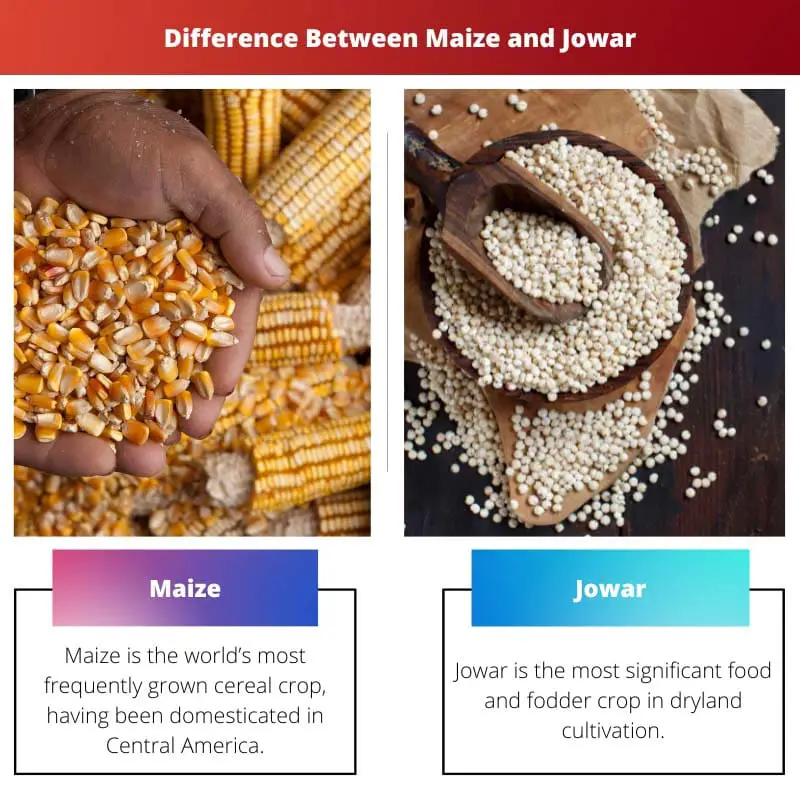Humans started to cultivate crops 10,000 years ago, as they evolve they started domesticating animals and growing different types of crops.
In the beginning, the early humans use to grow einkorn, emmer (ancient tetraploid wheat), lentils, flax, etc. Gradually, a new variety of crops, pulses, cereals were introduced and today we have a wide range of various crops to choose from.
Key Takeaways
- Maize, or corn, is a cereal grain commonly used in cooking and as animal feed.
- Jowar, or sorghum, is another cereal grain widely used in Indian cuisine.
- Maize has a higher carbohydrate content than jowar.
Maize vs Jowar
Maize is a common food source for many people. It is known as the queen of cereals and provides both nutrients that help to fight certain diseases in our body, and benefit our skin and eyes. Jowar is a grain that is rich in fiber. it is widely grown in India as a healthier option to wheat.

Once Christopher Columbus and his fellow explorers stopped on an archipelago near the northern Antilles, the island’s indigenous Tahino residents shared their main agricultural crop with them.
Their main food grain was corn; however, the Tahini peasants used to call it “mahiz,” in their native dialect meaning “source of life”.
Christopher Columbus carried specimens of the grain with him, and after reaching Spain “mahiz” was renamed as Maize and became famous all around the world.
Jowar, also known as Sorghum, is rich in fiber grain that is widely grown in India as a healthier option to refined wheat or all-purpose wheat.
It’s a floral grass from the Poaceae genus that’s grown all over the world, including Australia, Europe, Asia, etc. It has been a staple of human diets for almost 5000 years, spanning cultures all over the world.
Comparison Table
| Parameters of Comparison | Maize | Jowar |
|---|---|---|
| Botanical name | Zea mays subsp. mays | Sorghum |
| Discovered in | About 9,000 years ago | Around 4000–3000 B.C |
| Color of grains or kernels | Black, bluish-gray, purple, green, red, white, and yellow. | Ivory, purple, deep red, and brown colors. |
| Countries that grow these crops | USA, India, China, Brazil, etc | Nigeria, India, Mexico, Sudan, etc |
| Soil Requirements | Loamy sand to clay loam | Sandy loam soils that have good drainage. |
What is Maize?
Maize is the world’s most frequently grown cereal crop, having been domesticated in Central America. It is the most adaptable crop on the market.
Maize is recognized as the “Queen of Cereals” around the world due to its great hereditary yield capability. Maize is the only crop that can be cultivated in a variety of seasons, ecosystems, and uses.
Maize also comes in distinct varieties, including regular golden grain, sweet corn, baby corn, popcorn, and so on. Apart from this, Maize is a vital economic raw material with a lot of potential for productivity improvement.
Maize plants have 18 to 22 total leaflets, silk emerges around 55 days following emergence, and matures in about 125 days.
However, the period for its development may vary depending on hybrids, conditions, sowing date, and region. Maize also has various health benefits that can improve our health conditions and help us to fight many diseases. Some of its benefits are listed below:
– Maize has a wide range of important antioxidants, including the phytochemicals lutein and zeaxanthin, which help to improve vision.
– Maize is a distinctive plant-based resource of high-standard proteins because it contains a specific amount of key amino acids.
– Maize is the greatest provider of natural calcium, which helps kids’ bones develop stronger. It also aids in the relief of osteoporosis problems by restoring ideal bone density in elderly adults.

What is Jowar?
Jowar is the most significant food and fodder crop in dryland cultivation. It is perennial in origin, with corn-like stalks and cereal comportment dense clusters.
Jowar is the world’s fifth-most significant cereal grain. Because of its drought tolerance, it can be found in dry and semi-arid climates around the globe.
Jowar has the same nutrient benefit as Maize, which is why it is becoming more popular for feeding livestock, it can also be utilized for manufacturing ethanol, used in manufacturing alcohol, starch processing, adhesives manufacture, and paper-making.
Jowar is among India’s most important crops. Maharashtra accounts for half of the entire area for Jowar production in India.
Karnataka, Andhra Pradesh, Maharashtra, and Tamil Nadu produces 52 percent of the country’s total Jowar production.
Jowar also has the advantage of being able to be cultivated in both the Kharif and Rabi seasons.
It can also manage and thrive in a variety of soil types, spanning from fertile to low-nutrient soils, although its effectiveness is mostly dependent on soil humidity, permeability, and the porous nature of the soil.
If we consider its health benefits, they are huge in number, and including Jowar in your diet will be a wise move towards a healthy life. Some of it’s benefits are listed below:
– Jowar is a slow-digesting complex starch, that makes our blood sugar levels remain steady.
-Jowar contains 11 grams of protein per 100 grams, which provides energy to the body and helps in cell repair.
– Jowar aids in the maintenance of calcium concentration in the body due to its significant magnesium content.

Main Differences Between Maize and Jowar
1. Maize belongs to the Mays species of the plant whereas Jowar belong to S. bicolor species.
2. Maize is harvested within 90- 110 days after sowing while Jowar is harvested within 65- 75 days.
3. The common height of the Maize plant is 3 meters, while the height of Jowar is 0.5 to over 4.0 meters.
4. Maize is also known as “corn” whereas Jowar is also known as Sorghum.
5. In India the plantation time for Maize is June to September whereas the plantation time for Jowar is June to July.

- https://www.indianjournals.com/ijor.aspx?target=ijor:anft&volume=4&issue=1&article=006
- https://www.scielo.br/j/bjm/a/PSN6xYPxzNwm3PjKt5DSx6N/abstract/?lang=en
